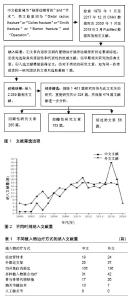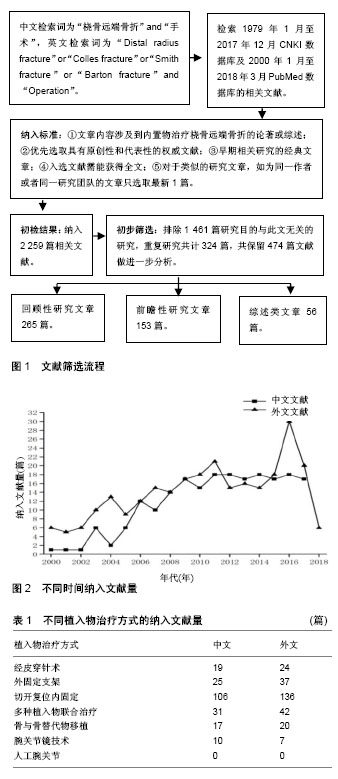Chinese Journal of Tissue Engineering Research ›› 2018, Vol. 22 ›› Issue (23): 3736-3743.doi: 10.3969/j.issn.2095-4344.0308
Previous Articles Next Articles
Criteria for choosing different implants in the treatment of distal radius fractures
Cui Meng-meng1, Hu Hai2, Cui Hai-yong2, Zhao Long-fei1, He Xiao-di1, Cheng Hao-jie3
- 1School of Medicine, Anhui University of Science and Technology, Huainan 232001, Anhui Province, China; 2Department of Orthopedics, First Affiliated Hospital of Anhui University of Science and Technology/First People’s Hospital of Huainan, Huainan 232001, Anhui Province, China; 3Suzhou Institute of Biomedical Engineering and Technology, Chinese Academy of Sciences, Suzhou 215163, Jiangsu Province, China
-
Online:2018-08-18Published:2018-08-18 -
Contact:Cui Meng-meng, School of Medicine, Anhui University of Science and Technology, Huainan 232001, Anhui Province, China -
About author:Cui Meng-meng, School of Medicine, Anhui University of Science and Technology, Huainan 232001, Anhui Province, China -
Supported by:the Science and Technology Project of Anhui Province, No. W2015QJ064; Huainan Science and Technology Program, No. 2015A2407
CLC Number:
Cite this article
Cui Meng-meng, Hu Hai, Cui Hai-yong, Zhao Long-fei, He Xiao-di, Cheng Hao-jie. Criteria for choosing different implants in the treatment of distal radius fractures[J]. Chinese Journal of Tissue Engineering Research, 2018, 22(23): 3736-3743.
share this article

2.1 纳入文献基本概况 检索文献共2 259篇,纳入文献共474篇,包括临床病例的回顾性研究文章265篇,前瞻性研究文章153篇,综述类文章56篇。文献检索流程见图1。 中文共208篇,其中2017年17篇,2016年18篇,2015年17篇,2014年18篇,2013年17篇,2012年18篇,2011年18篇,2010年15篇,2009年17篇,2008年14篇,2007年10篇,2006年12篇,2005年6篇,2004年2篇,2003年6篇,2002年1篇,2001年1篇,2000年1篇。 外文共266篇,其中2018年6篇,2017年20篇,2016年30篇,2015年18篇,2014年15篇,2013年16篇,2012年15篇,2011年21篇,2010年18篇,2009年17篇,2008年14篇,2007年15篇,2006年12篇,2005年9篇,2004年13篇,2003年10篇,2002年6篇,2001年5篇,2000年6篇。各年代纳入文献量见图2。 2.2 植入物治疗方式的选择 不同植入物治疗方式的纳入文献分布见表1。 2.2.1 经皮穿针术 通过经皮穿针术可以解决闭合复位后再移位的问题,适应证为复位后发生再移位的骨折,关节外的骨折和不能靠外固定保持位置但能够闭合复位的关节内骨折[5],而禁忌证为骨质疏松。它可单独应用,也可结合外固定架或石膏外固定以提高疗效。 不同类型的骨折有不同的穿针技术。穿针部位有:①桡骨茎突处穿针,如Lambotte技术(1908 年)、Stein技术(1975年)及 Uhl技术(1976年);②于尺骨茎突下进针穿过尺桡骨,如Dcpalma技术(1952年)、Ray-hack技术(1989年);③经过下尺桡关节穿针,如Uhl和Ray-hack技术;④经过骨折间隙进针,如Kapandji技术(1976年)等。其中应用较多的是Kapandji技术,特点是克氏针不能直接固定骨碎片,而是支持骨碎片。 蔡有根等(2005年)[6]用改良的经皮克氏针固定术治疗了20例重度桡骨远端粉碎性骨折患者,手术获得了良好的效果并恢复了患者的腕部功能。Kharwadkar等(2005年)[7]采用闭合复位纵向克式针治疗53例移位的Colles骨折患者,明显改善了骨折位置,这是一项有吸引力的技术,因为它创伤很小。 Günay等(2015年)[8]用经皮克式针治疗92例桡骨远端骨折,其中45例使用了3根克式针,行掌侧半圆形支持,并用可移除夹板固定3周;47例使用了2根克式针,行下肘环形支持,组间握力和DASH评分差异无显著性意义,术后6周,3根克式针组的桡骨倾斜度和长度恢复更好,这是一种安全可靠的技术。Rubin等(2016年)[9]采用掌侧 intrafocal Kapandji方法治疗3例桡骨远端骨骺骨折,术后目测类比评分为0,没有并发症,这是一种新的微创技术。Guo等(2017年)[10]采用改良Sauve-Kapandji治疗15例桡骨远端陈旧性骨折患者,改良的Mayo腕关节评分优良率100%,这是一种很好的治疗方法[11]。 从2005至2017年纳入研究的文献,提示经皮穿针术治疗移位 Colles骨折、桡骨远端的骨骺或粉碎性骨折有效,各方法具有微创、操作容易,对肌腱功能损伤小,易于取出的特点。 2.2.2 外固定支架技术 对于桡骨远端关节外不稳定的骨折、开放的关节内骨折及粉碎的干骺端骨折,多采用外固定架进行治疗。外固定支架首选用于治疗明显缩短的桡骨远端粉碎性骨折。目前,外固定支架在临床上种类繁多,例如 Hoffmann、AO、Orthofix等。外固定支架有关节周围和超关节2种使用方式[12],可分成静力型和动力型。这些外固定架各有特点,术者根据骨折的分型选择相应的外固定架。具体选择应根据骨折类型来定:①关节周围的外固定支架多用于治疗关节外骨折和部分涉及桡尺关节的骨折,其远端针穿过桡骨远端骨片,近端最少距桡骨骨干骨折线3.0-4.0 cm;②超关节的外固定支架多应用于治疗合并桡腕或桡尺关节损伤的关节内骨折,其远端针穿过第二掌骨,近端最少距桡骨骨干骨折线3.0-4.0 cm。 鞠杰等(2010年)[13]对27例不稳定性桡骨远端骨折患者应用HoffmannⅡ外固定架治疗,AO分型:A3型8例,C3型19例,Dienst功能评估标准评定优良率59.3%,说明这是可靠的治疗方法[14]。魏磊平等(2011年)[15]对37例桡骨远端不稳定骨折患者采用超关节外固定支架治疗,AO分型:B3型15例,C2型9例,C3型13例,Dienst功能评估标准评定优良率87.1%,手术获得较好的疗效。向秀根(2011年)[16]就15例不稳定的桡骨远端骨折患者采用动力型外固定架治疗,AO分型: C1型5例,C2型7例,C3型3例,Sarmiento标准评定优良率73.3%,手术促进了腕部功能的恢复[17]。 黄晓楠(2015年)[18]对122例桡骨远端骨折患者采用外固定器治疗,AO分型:C1型16例,C2型63例,C3型43例,改良Mcbride评分标准评价优良率61.5%,它适用于修复桡骨远端C型骨折[19]。Chilakamary等(2016年)[20]采用常规桥接外固定架治疗26例桡骨远端不稳定关节外和复杂关节内骨折,手术取得良好的疗效,故这是一种有效的方法。 回顾2010至2016年间的文献,病例大多采用AO分型,多项研究提示外固定支架治疗桡骨远端不稳定骨折均获得较好的效果,平均优良率为70.3%,外固定支架的特点:微创手术,手术简单,无需二次手术,门诊可拆除,对邻近组织的损失小,闭合性复位保留了骨膜,不改变骨折端血液供应,利于术后骨折愈合。同时术后也有许多常见的并发症:调节复位困难、骨折再移位、针部感染、针道处骨折、固定针或支架摇动等。随着外固定器治疗技术的逐渐改进,外固定器治疗桡骨远端骨折的成效被更加认可。 2.2.3 切开复位植入物内固定术 对于保守治疗失败,不愈合及陈旧性畸形愈合的骨折,多使用开放复位植入物内固定治疗。此外,开放复位植入物内固定术被更多的用于治疗一些很不稳定的骨折,如陈旧的桡骨远端骨折、关节内复杂的骨折以及涉及下尺桡关节断离的骨折。手术治疗的目的是恢复桡骨远端关节面的解剖形态和恢复腕关节的功能。 按内固定材料可分为T型普通钢板、T型锁定加压钢板、AO接骨板、π钢板、DVR型钢板、髓内钉等。目前临床上最常用的是T型普通钢板和T型锁定加压钢板。锁定加压钢板系统的特征在于把钢板自锁系统和加压系统结合在一起,其远端的自锁螺钉可以预防脱钉和骨折再移位。锁定加压钢板钢板的生物力学稳定性较好,适用于伴骨质疏松的桡骨远端骨折和AO分型中的C2、C3型骨折。 Sasaki(2002年)[21]采用Desmanet髓内钉治疗102例桡骨远端骨折,根据斋藤的评分制度,优良率100%,该方法是老年骨质疏松症患者的良好选择。张殿英等(2004年)[22]对19例桡骨远端骨折患者采用斜T形锁定加压接骨板治疗,AO分型:B1型3例,B2型8例,B3型8例,C1型7例,C2型4例,C3型1例,腕关节功能及 X射线片测量指标综合评定优良率100%,手术取得了良好的治疗效果。黄斌等(2005年)[23]采用AO支撑钢板治疗19例中老年粉碎性桡骨远端骨折患者,AO分型A2型2例,A3型5例,B2型3例,C1型3例,C2型5例,C3型1例,改良Green and O’Brien标准评定优良率100%[24],手术获得了满意的疗效。 李国风等(2008年)[25]就32例桡骨远端粉碎性骨折患者应用背侧π钢板治疗,AO分型:B2型16例,C1型9例,C2型7例,Gartland和Werley腕关节评分评定优良率100%,此法治疗可靠[26]。Yasuda等(2009年)[27]采用可变角度的掌侧锁定钢板治疗40例Colles骨折患者,获得令人满意的临床和放射学结果,该方法较为可靠,但有一定的技术错误。 Gutierrez等(2015年)[28]对13例桡骨远端不稳定骨折患者应用掌侧锁定钢板微创治疗,上肢、肩、手功能障碍(disabilities of the arm, shoulder and hand, DASH)评分、目测类比评分平均为13.91,0.92分,骨折获得了良好的复位和固定,术后患者疼痛水平低。Javed等(2015年)[29]采用掌侧锁定钢板固定治疗62例桡骨远端骨折,Fernandez分类:1型20例,2型24例,3,4和5型均为6例,手术取得了良好的结果,植入物相关的并发症发生率较低。Yamashita等(2015年)[30]通过早期和延迟使用掌侧锁定钢板治疗106例桡骨远端背侧移位的关节外骨折,分为2组,E组76例(受伤当天或次日手术),D组30例(受伤7 d后手术),随访4周,E组的患者有较好的前臂运动范围,随访48周,在手腕和前臂的运动范围和握力测量中,组间差异无显著性意义,故早期治疗有较好的近期成效。O’Shaughnessy等(2015年)[31]采用掌侧钩钢板治疗25例(26腕)伴有掌侧边缘碎片的桡骨远端关节内骨折,AO分型:B3型6腕,C1型1腕,C2型7腕,C3型12腕,术后5例需要去除硬件,其中4例受到了硬件刺激,需移除所有硬件,1例需移除部分硬件,改良弯钩的设计可减少这种并发症。Lauder等[32](2015年)采用背侧牵引桥板治疗100例粉碎性桡骨远端关节内骨折患者,均为AO-C3型,术后有2例手术部位疼痛,无感染,无肌腱炎或肌腱断裂,故该植入物固定安全,并发症少。Lee等(2015年)[33]采用Frag-Loc压缩螺钉治疗48例桡骨远端不稳定骨折,术后CT扫描示加压螺钉可以缩短背侧碎片与桡骨远端之间的距离,这是一种有效简单的治疗方法。 Kara等(2016年)[34]采用解剖锁定钢板治疗36例掌侧缘粉碎性桡骨远端骨折,AO分型为 C2、C3型,Mayo腕关节评分优27例,疗效满意。Naito等[35]和Takeuchi等[36](2016年)分别对18例和20例桡骨远端骨折患者采用掌侧锁定钢板治疗,术后患侧握力分别为健侧的35%-100%和94%,故该植入物治疗可靠。Kachooei等(2016年)[37]采用掌侧缘板治疗10例桡骨远端掌侧缘骨折,AO分型:A型1例,B3型23例,C型6例,所有骨折均愈合,Gartland和Werley评分优良率为80%,术后有着良好的功能结果。Tanaka等(2016年)[38]采用2种掌侧钢板(远端组A组、近端组B组)治疗64例桡骨远端骨折,均取得了满意的结果,但放置在远端的钢板会延迟腕部功能的恢复。Falk等(2016年)[39]采用闭合复位交锁髓内钉治疗43例单侧孤立性桡骨远端骨折,AO分型为A、C型,Gartland Werley评分均为优秀,故该手术是可行的。Wakasugi等(2016年)[40]采用髓内植入物治疗40例关节外或单纯关节内桡骨远端骨折患者,均获得骨性愈合,改良Mayo评分平均为91.9分,优良率90%,该植入物治疗有良好的放射学和功能结果。Hagenaars 等[41](2016年)采用IlluminOss系统(微创髓内固定术)治疗单侧移位的关节外桡骨远端骨折,AO分型为A2、A3型,该方法治疗有效。lselin等(2016年)[42]采用掌侧和背侧内固定治疗12例复杂桡骨远端骨折,均为AO-C3型,随访10年,活动范围有8例优异,DASH评分和腕关节患者自评量表评分的中位数分别为2.3和6.0分,该治疗在中长期随访中有良好的功能结果。Fan等(2016年)[43]采用复合型内固定治疗12例桡骨远端骨折,AO分型:B1型4例,B2型3例,C1型3例,C3型2例,所有骨折均愈合,该治疗有效,减少了软组织损伤。Natoli等(2016年)[44]采用外固定器转化为切开复位内固定治疗16例桡骨远端复杂骨折患者,AO分型:A3型1例,B3型1例,C1型2例,C2型3例,C3型9例,术后有1例发生感染,故该方法在控制损害的情况下是合理的。 Yoon等(2017年)[45]对85例桡骨远端关节内粉碎性骨折应用掌侧锁定钢板治疗,AO分型:C2型50例,C3型35例,术后临床评估显示C2型效果优于C3型,故该植入物更适于C2型骨折。Bae等(2017年)[46]采用掌侧锁定钢板治疗72例干骺端不稳定的桡骨远端骨折,分为A组(手术延迟2-6周)24例,B组(手术延迟≤2周)48例,术后3个月时B组腕部屈曲和握力高于A组,但术后1年时运动范围,握力和DASH评分差异无显著性意义,故术后早期B组比A组的临床结果更好,术后1年达到相似的临床结果。Zhang等(2017年)[47]采用单侧锁定钢板治疗93例B型桡骨远端骨折,其中月骨面受累为第1组(n= 21),未受累为第2组(n=72),均达到骨性愈合,但涉及月骨面的骨折恢复较慢。Eme等(2017年)[48]采用碎片特异性固定治疗25例粉碎性关节内桡骨远端骨折,均为AO-C2型,患侧旋前和旋后有显著差异,握力为健侧的76%,该方法治疗合理有效,有很好的临床、放射学和功能结果。Spiteri等(2017年)[49]采用可变角度的2.4 mm远端外缘板治疗26例桡骨远端关节内骨折,分为AO-C2、C3型,术后DASH评分为17.6分,该植入物治疗结果令人满意。Kotian等(2017年)[50]采用2.7 mm掌侧锁定加压钢板治疗20例移位的桡骨远端骨折,Sarmiento改良的Lidstrom标准示放射性结果中优良率75%,故该植入物治疗有很好的放射性结果[51]。Varga等(2017年)[52]对24例严重移位的桡骨远端骨折患者采用短双弹性髓内钉治疗,术后所有的儿童患者均恢复了全方位的运动,无并发症,这项技术是安全有效的。 回顾2002至2017年间纳入的文献,病例骨折分型也大多为AO分型,提示切开复位植入物内固定治疗桡骨远端不稳定、粉碎性、复杂性、移位骨折,均安全有效,平均优良率为94.2%,患者可为青年、中老年人,以中老年人且可以达到解剖复位,易于恢复桡骨的茎突高度、掌倾尺偏角,早期腕关节功能恢复较好。但开放复位内植物固定治疗具有切口相对较大,邻近组织损伤大,肌腱磨损,术后恢复时间长等缺点。 2.2.4 多种植入物联合治疗 唐昊等(2007年)[53]对35例背侧移位的桡骨远端不稳定骨折采用掌侧锁定加压钢板联合克氏针撬拨、植骨治疗,AO分型:A3型21例,B2型8例,C2型4例,C3型2例,Sarmiento标准评定优良率91.4%,手术取得了有效疗效。Iida等[54](2010年)采用磷酸钙骨水泥辅助球囊成形术治疗11例Colles型骨折(AO-A2型),均在3个月内评定为优秀或良好,并在最终随访中评分均为优秀,此法是侵袭力较小的治疗方法,是骨质疏松的老年女性Colles骨折患者的良好选择。Zhang等(2014年)[55]采用2.4 mm AO锁定钢板联合经皮穿针治疗19例(21腕)桡骨远端骨折患者,均为 AO-C3型,Sarmiento改良的Gartland-Werley评分优良率95.2%[56],联合手术治疗可取得满意疗效。丁宁等(2014年)[57]对36例陈旧性C3型桡骨远端骨折采用掌侧解剖锁定钢板结合单臂跨腕关节外固定器治疗,均为AO-C3型,Gartland和Werley评分评定:优良率为75%,这是一种很好的手术方式。 唐理英等(2015年)[58]对20例骨质疏松的桡骨远端骨折采用经皮注射磷酸钙骨水泥联合有限切开克式针固定治疗,AO分型:A3型7例,B3型1例,C1型1例,C2型7例,C3型4例,Gartland和Werley评分评定平均为7.5分,磷酸钙骨水泥对于骨质疏松症患者是一种很好的填充材料,不具有自体及异体骨移植的劣势,可以直接支撑骨折块。钱光等(2016年)[59]对23例背侧移位桡骨远端不稳定的骨折患者采用掌侧锁定加压钢板结合背侧支撑钢板治疗,AO分型:C2型8例,C3型15例,Sarmiento标准评定:优良率100%,术后患者获得较好的腕部功能。Strassmair等(2016年)[60]采用带锁髓内钉联合特定片段的螺钉治疗100例桡骨远端骨折,平均腕关节评分在3个月时为21分,12个月时为11分,有5例发生不良事件:涉及桡神经刺激2例,肌腱刺激3例,此法治疗有效。Dardas等(2018年)[61]采用掌侧锁定钢板联合单皮质螺钉治疗75例桡骨远端骨折,AO分型:A型40%,B型12%,C型48%,术后没有伸肌腱鞘炎或伸肌腱断裂,该方法可有效保持骨折手术复位,也使伸肌腱断裂的发生率最小化。 该组病例大多采用AO分型,根据回顾2007至2018年间的文献,提示多种类型植入物联合治疗桡骨远端骨质疏松性骨折均获得较好的效果,骨或骨替代物移植被更多的应用于骨质疏松骨折。同时多种类型植入物联合治疗桡骨远端不稳定骨折均有较好的效果,平均优良率为95.7%;同时对桡骨远端 C型骨折的治疗也取得了满意疗效,平均优良率为90.1%。因此,对于部分复杂性骨折,术者可以利用不同内植物的特点相互搭配,进而扬长避短。针对单一植入物无法有效固定的桡骨远端骨折,经多种植入物联合治疗后手术复位程度及功能恢复往往可以取得较为满意的疗效。 2.2.5 骨或骨替代物移植 桡骨远端骨折常出现干骺端处的骨缺损,治疗通常需要骨或骨替代物,主要适用于桡骨远端粉碎的骨折,压缩性干骺端骨折及复位后关节面缺损和下沉的骨折。植骨目的是支持桡骨远端关节内的碎骨片,缩减外固定时间,促进骨生长和骨愈合,为减少早期功能锻炼发生并发症而创造条件[62-63]。现今骨移植的材料有自体骨、异体骨和人工骨及可吸收材料等替代品。最佳的骨移植物是自体松质骨,寻求与其相当的骨替代物是之后研究的方向。近年来骨替代物的研究进展迅速,如骨水泥、陶瓷衍生物及生物活性玻璃等。近年来可注射磷酸钙骨水泥是发展较为迅速的一种生物活性骨替代材料,具有生物相容性好、原位固化、牢固固定、成骨同时分解等优点,是可靠的内固定和骨填充材料,可以较好的治疗桡骨远端骨折,也可以在外固定时进行加固。 Hidaka等(2002年)[64]采用磷酸钙骨水泥(CPC95)治疗7例骨质疏松的Colles型骨折,所有患者在3个月内评定为良好或优秀,在最终随访中评分均优异,这种材料治疗有效。Ho等(2017年)[65]于关节镜下取股骨外侧髁进行自体骨移植治疗,4例患者的腕部功能均有所改善,3例患者进行第2次关节镜检查时证实保留了正常的关节软骨,患者满意度高,无并发症。Henry(2017年)[66]采用游离血管的内侧股骨髁皮瓣(中央块状移植物和延伸的皮质骨膜)治疗6例桡骨远端骨折,术前平均DASH评分为63分,与术后平均DASH评分18分相比,统计学差异有著性意义。 根据对2002与2017年文献的回顾性研究,提示骨或骨替代物移植治疗各型桡骨远端骨折均取得满意的疗效。虽然移植的自体骨丧失了血液供应,但是它具有骨传导性和骨诱导性,可以支撑骨骼的结构,而且可以被有血供的骨组织替代。但自体骨的来源较少,且有出血部位炎症和疼痛增加、病理性骨折增多及治疗时间加长等劣势。而同种异体骨移植具有数量较少、花费高昂及病毒传播等缺点。 2.2.6 腕关节镜技术 腕关节镜检查是一种微创手段,应用于AO分型的B、C型。腕关节镜在腕关节内骨折治疗时有以下作用[62]:①直接观察骨折复位和固定的情况;②观察关节软骨的损伤情况;③取出关节内骨和软骨碎片;④检查韧带和软骨的完整性,并尽量通过镜下做清洁或整复。在关节镜监视下进行复位和固定是对切开复位内固定进行辅助,在处理桡骨远端严重关节内骨折上有着明显的优势。 章亚东等(2005年)[67]对15例桡骨远端关节内骨折采用腕关节镜辅助可动力化外固定器治疗,AO分型:B2型3例,B3型2例,C1型3例,C2型6例,C3型1例,Sarmiento改良的Gartland-Werley评分评价优良率93.3%,联合治疗恢复了桡骨关节面的平坦和保持了关节面的高度。 Lutz等(2016年)[68]采用腕关节镜辅助固定角度的锁定钢板联合克式针固定于钢板远端治疗23例桡骨远端关节内骨折,DASH评分为4.9分,平均腕功能评分为6分,握力平均为96%。Cheng等(2016年)[69]采用关节镜辅助Herbert螺钉治疗28例桡骨远端B型骨折,AO分类:B1型8例,B2型7例,B3型13例,Cooney系统评估优良率92.9%,该方法恢复了关节面的平整。 根据对2005与2016年文献的回顾性分析,提示通过腕关节镜辅助治疗桡骨远端关节内骨折均获得满意疗效,2005年、2016年文献的优良率分别为93.3%,92.9%,且腕关节镜技术具有微创,直接观察到损伤及复位固定情况,辅助其他植入物治疗等特点。 2.2.7 人工腕关节 随着人工腕关节假体的设计、材料以及相关术式均得到不断改进、完善,人工腕关节被更多的应用于患者的治疗,适用于创伤性、类风湿性、化脓性腕关节炎的治疗。如应用得当,可显著改善患者腕部功能,提高患者生活质量。由于人工腕关节已经发展了40余年,仍具有假体摇动、下沉、断裂、脱位等并发症,故现今第3,4代假体还有待于远期随访观察。 "

| [1] Hanel DP, Jones MD, Trumble TE. Wrist fractures. Orthop Clin North Am. 2002;33(1):35-57.[2] Wiemer P, Köster G, Felderhoff J, et al. Fractures of the distal radius. Changing therapeutic strategies. Der Orthopäde. 1999;28(10):846.[3] Bengnér U, Johnell O. Increasing incidence of forearm fractures. A comparison of epidemiologic patterns 25 years apart. Acta Orthopaedica Scandinavica. 1985;56(2):158.[4] 张淼. 我国农村老年人养老状况及满意度分析[J]. 调研世界,2016,29(6): 8-12.[5] 张林林,胡孔足,卜海富. 桡骨远端骨折治疗进展[J]. 临床骨科杂志,2012, 15(2):209-213.[6] 蔡有根, 冯皓. 改良经皮克氏针固定治疗桡骨远端严重粉碎性骨折[J]. 江西医药, 2005,40(3):147-149.[7] Kharwadkar N. Do Kirschner wires maintain reduction of displaced Colles fractures? Injury. 2005;36(12):1431.[8] Günay C, ÖF Ö, Yavuz OY, et al. Which modality is the best choice in distal radius fractures treated with two different Kirschner wire fixation and immobilization techniques? Ulus Travma Acil Cerrahi Derg. 2015; 21(2):119-126. [9] Rubin G, Orbach H, Chezar A, et al. Treatment of physeal fractures of the distal radius by volar intrafocal Kapandji method: surgical technique. Arch Orthop Trauma Surg. 2016;137(1):1-6.[10] Guo Z, Wang Y, Zhang Y. Modified Sauve-Kapandji Procedure for Patients with Old Fractures of the Distal Radius. Open Med. 2017;12(1):417-423.[11] Gupta R, Raheja A, Modi U. Colles' fracture: management by percutaneous crossed-pin fixation versus plaster of Paris cast immobilization. Orthopedics. 1999;22(7):680.[12] Pennig D, Gausepohl T. External fixation of the wrist. Injury. 1996;27(1): 1-15.[13] 鞠杰,王黎明,沈海琦,等. HoffmannⅡ外固定支架技术在桡骨远端骨折中的应用[J]. 东南大学学报(医学版),2010,29(5):555-558.[14] Dienst M, Wozasek GE, Seligson D. Dynamic external fixation for distal radius fractures. Clin Orthop Relat Res. 1997;338(338):160.[15] 魏磊平,徐勇强,贾真,等. 超关节外固定架治疗37例桡骨远端不稳定骨折[J]. 广东医学,2011,32(6):776-777.[16] 向秀根. 15例动力型外固定支架治疗桡骨远端关节内不稳定性骨折的疗效分析[J]. 重庆医学,2011,40(11):1111-1113.[17] Sarmiento A, Pratt GW, Berry NC, Sinclair WF. Colles' fractures. Functional bracing in supination. J Bone Joint Surg. 1975;57(3): 311-317.[18] 黄晓楠. 老年桡骨远端AO C型骨折修复:闭合复位外固定支架的生物学优势[J]. 中国组织工程研究,2015,19(35):5684-5690.[19] Nellas ZJ, Loder BG, Wertheimer SJ. Reconstruction of an Achilles tendon defect utilizing an Achilles tendon allograft. J Foot Ankle Surg. 1996;35(2):144.[20] Chilakamary VK, Lakkireddy M, Koppolu KK, et al. Osteosynthesis in Distal Radius Fractures with Conventional Bridging External Fixator; Tips and Tricks for Getting Them Right. J Clin Diagn Res. 2016;10(1):RC05.[21] Sasaki S. Modified Desmanet's intramedullary pinning for fractures of the distal radius. J Orthop Sci. 2002;7(2):172-181.[22] 张殿英,姜保国,傅中国,等. 斜T形锁定加压接骨板治疗桡骨远端骨折的临床研究[J]. 中华手外科杂志,2004,20(1):24-26.[23] 黄斌,欧阳振华,吕汉棠. 应用AO支撑钢板治疗中老年桡骨远端粉碎性骨折[J]. 中华创伤骨科杂志,2005,7(9):887-888.[24] Green DP, O'Brien ET. Open reduction of carpal dislocations: Indications and operative techniques. J Hand Surg. 1978;3(3):250.[25] 李国风,蔡俊丰,李增春,等. 背侧入路π钢板治疗桡骨远端骨折[J]. 中国骨伤,2008,21(7):534-535.[26] 张兴平,郭建安,袁纯峰. 复位固定器治疗不稳定型Colles骨折[J]. 中国骨伤, 1999,12(5):52-53.[27] Yasuda M, Ando Y. A new variable angled locking volar plate system for Colles' fracture: outcome study and time-course improvement of objective clinical variables. Hand Surg. 2010;14:0900430.[28] Gutierrez ON, Ruchelli L, Iglesias S, et al. Minimally invasive plate osteosynthesis in distal radius fractures with metaphyseal extension: a series of 13 cases. Chirurgie de la main. 2015;34(5):227-233.[29] Javed S, Shahid R, Thimmiah R, et al. Volar locking plate osteosynthesis for distal radial fractures. J Orthop Surg. 2015;23(3): 323.[30] Yamashita K, Zenke Y, Sakai A, et al. Comparison of Functional Outcome Between Early and Delayed Internal Fixation Using Volar Locking Plate for Distal Radius Fractures. J Uoeh. 2015;37(2):111-119.[31] O'Shaughnessy MA, Shin AY, Kakar S. Volar Marginal Rim Fracture Fixation With Volar Fragment-Specific Hook Plate Fixation. J Hand Surg. 2015;40(8):1563-1570.[32] Lauder A, Agnew S, Bakri K, et al. Functional Outcomes Following Bridge Plate Fixation for Distal Radius Fractures. J Hand Surg. 2015; 40(8):1554-1562.[33] Lee JI, Cho JH, Lee SJ. The effects of the Frag-Loc(®) compression screw on distal radius fracture with a displaced dorsoulnar fragment. Arch Orthop Trauma Surg. 2015;135(9):1315-1321.[34] Kara A, Celik H, Oc Y, et al. Flexor tendon complications in comminuted distal radius fractures treated with anatomic volar rim locking plates. Acta Orthopaedica Et Traumatologica Turcica. 2016; 50(6):665.[35] Naito K, Zemirline A, Sugiyama Y, et al. Possibility of Fixation of a Distal Radius Fracture With a Volar Locking Plate Through a 10 mm Approach. Tech Hand Up Extrem Surg. 2016;20(2):71.[36] Takeuchi N, Hotokezaka S, Okada T, et al. Recovery of Wrist Function after Volar Locking Plate Fixation for Distal Radius Fractures. J Hand Surg Asian Pac. 2016;21(2):199-206.[37] Kachooei AR, Tarabochia M, Jupiter JB. Distal Radius Volar Rim Fracture Fixation Using DePuy-Synthes Volar Rim Plate. Jnl Wrist Surg. 2016;5(1):2.[38] Tanaka H, Hatta T, Sasajima K, et al. Comparative study of treatment for distal radius fractures with two different palmar locking plates. J Hand Surg Eur. 2016;377(1):97-110.[39] Falk SS, Mittlmeier T, Gradl G. Results of geriatric distal radius fractures treated by intramedullary fixation. Injury. 2016;47:S31-S35.[40] Wakasugi T, Shirasaka R. Intramedullary Nail Fixation for Displaced and Unstable Distal Radial Fractures in Patients Aged 65 Years or Older. J Hand Surg Asian Pac Vol. 2016;21(1):59-63. [41] Hagenaars T, Oijen GWV, Roerdink WH, et al. Functional recovery after treatment of extra-articular distal radius fractures in the elderly using the IlluminOss® System (IO-Wrist); a multicenter prospective observational study. Bmc Musculoskeletal Disorders. 2016;17(1):235.[42] Iselin LD, Massybudmiger AS, Droeser RA, et al. Ten Years’ Follow-Up on Combined Palmar and Dorsal Internal Fixation of Complex Distal Radius Fractures. Medicine. 2016;95(18):e3509.[43] Fan J, Jiang B, Yuan F, et al. [Clinical effect of compound internal fixations in treating extreme distal radial fractures]. Zhonghua wai ke za zhi. 2016;54(10):766.[44] Natoli RM, Baer MR, Bednar MS. Conversion of external fixation to open reduction and internal fixation for complex distal radius fractures. Orthop Traumatol Surg Res. 2016;102(3):339-343.[45] Yoon JO, You SL, Kim JK. Intra-articular comminution worsens outcomes of distal radial fractures treated by open reduction and palmar locking plate fixation. J Hand Surg Eur Vol. 2017;42(3):260.[46] Bae JY, Yoon JO, Choi SW, et al. Comparison of outcomes between partially healed and acute metaphyseally malaligned distal radial fracture treated by palmar locking plate fixation. J Orthop Sci. 2017; 22(6):1049-1053. [47] Zhang X, Zhao Y, Hu C, et al. Comparative study of type B distal radius fractures with and without lunate facet involvement treated by volar locking plate, an observational study. Int J Surg. 2017;44:317-323.[48] Eme B, Almaqdassy ED, Hasan K, et al. Efficiency of fragment specific fixation plates in the treatment of comminuted distal radial fractures. Int Orthop. 2017;41(9):1763-1769.[49] Spiteri M, Ng W, Matthews J, et al. Functional Outcome of Fixation of Complex Intra-articular Distal Radius Fractures with a Variable-Angle Distal Radius Volar Rim Plate. J Hand Microsurg. 2017;9(1):11.[50] Kotian P, Mudiganty S, Annappa R,et al. Radiological Outcomes of Distal Radius Fractures Managed with 2.7mm Volar Locking Plate Fixation-A Retrospective Analysis. J Clin Diagn Res. 2017;11(1):RC09.[51] Eerten PVV, Lindeboom R, Oosterkamp AE, et al. An X-ray template assessment for distal radial fractures. Arch Orthop Trauma Surg. 2008; 128(2):217.[52] Varga M,Józsa G, Fadgyas B, et al. Short, double elastic nailing of severely displaced distal pediatric radial fractures: A new method for stable fixation. Medicine. 2017;96(14):e6532.[53] 唐昊,王秋根,张秋林,等. 掌侧钢板固定治疗不稳定的背侧移位桡骨远端骨折[J]. 中国矫形外科杂志,2007,15(22):1681-1683.[54] Iida K, Sudo A, Ishiguro S. Clinical and radiological results of calcium phosphate cement-assisted balloon osteoplasty for Colles’ fractures in osteoporotic senile female patients. J Orthop Sci. 2010;15(2):204-209.[55] Zhang C, Zhang ZJ, Wang L, et al. Treatment of type C3 distal radius fractures with AO 2.4 mm locking plate system after manipulative reduction. Zhongguo gu shang. 2014;27(11):965.[56] Schneiders W, Biewener A, Rammelt S, et al. Distal radius fracture. Correlation between radiological and functional results. Der Unfallchirurg. 2006;109(10):837.[57] 丁宁,贾健,刘兆杰,等. 内外联合固定治疗桡骨远端陈旧性C3型骨折[J]. 中国矫形外科杂志, 2014,22(4):361-364.[58] 唐理英,刘运辉,谢诗涓,等. 经皮注射磷酸钙骨水泥治疗桡骨远端骨质疏松性骨折的临床应用[J]. 临床医学工程, 2015,22(6):709-710.[59] 钱光,吴俊国,董有海,等. 掌侧锁定接骨板结合背侧支撑钢板固定治疗不稳定的背侧移位桡骨远端骨折[J]. 中国矫形外科杂志,2016,24(24): 2291-2293.[60] Strassmair MK, Jonas M, Schäfer W, et al. Distal Radial Fracture Management With an Intramedullary Cage and Fragment Fixation. J Hand Surg. 2016;41(8):833-840.[61] Dardas AZ, Goldfarb CA, Boyer MI, et al. A Prospective Observational Assessment of Unicortical Distal Screw Placement During Volar Plate Fixation of Distal Radius Fractures. J Hand Surg Am. 2018.[62] Duncan SF, Weiland AJ. Minimally invasive reduction and osteosynthesis of articular fractures of the distal radius. Injury. 2001;32(5):14-24.[63] Liptak JM, Ehrhart N, Santoni BG, et al. Cortical bone graft and endoprosthesis in the distal radius of dogs: a biomechanical comparison of two different limb-sparing techniques. Vet Surg. 2006;35(2):150.[64] Hidaka N, Yamano Y, Kadoya Y, et al. Calcium phosphate bone cement for treatment of distal radius fractures: a preliminary report. J Orthop Sci. 2002;7(2):182-187.[65] Ho PC, Tse WL, Wong CW. Arthroscopic Transplantation of Osteochondral Autograft for Treatment of Cartilage Defects in the Wrist. Hand Clinics. 2017;33(4):755.[66] Henry M. Vascularized Medial Femoral Condyle Bone Graft for Resistant Nonunion of the Distal Radius. J Hand Surg Asian Pac Vol. 2017;22(1):23-28.[67] 章亚东,侯树勋,李文锋,等. 腕关节镜辅助可动力化外固定器技术治疗桡骨远端关节内骨折[J]. 中华创伤骨科杂志,2005,7(3):245-249.[68] Lutz M, Erhart S, Deml C, et al. Arthroscopically assisted osteosynthesis of intraarticular distal radius fractures. Operative Orthopädie Und Traumatologie. 2016;28(4):1-12.[69] Cheng YB, Yang S. Wrist arthroscopy assisted reduction and Herbert screw fixation for the treatment of type B distal radius fractures. Zhongguo gu shang. 2016;29(9):859.[70] Sammer DM, Kawamura K, Chung KC. Outcomes using an internal osteotomy and distraction device for corrective osteotomy of distal radius malunions requiring correction in multiple planes. J Hand Surg. 2006;31(10):1567. |
| [1] | He Ke-yun, Li Zhi-zhong, Hu Zhao-hui. Variations of sacral slope at the early stage after posterior lumbar interbody fusion and its clinical significance [J]. Chinese Journal of Tissue Engineering Research, 2017, 21(15): 2361-2365. |
| [2] | Cui Zhi-yong, Wang Xue, Guo Peng-chao, Wang Cheng-wei. One-stage artificial joint replacement for unstable intertrochanteric fracture in aged patients: 6-month follow-up of hip joint function [J]. Chinese Journal of Tissue Engineering Research, 2015, 19(26): 4123-4126. |
| [3] | Yu Kai, Yang Jing, Yang Guang-zhong, AiHeMaiTiJiang, Chen Ke-yi, Zhao Di-qing, Yuan Chun-xiao. Parameter selection for steel ring of Ilizarov external fixation in the treatment of tibial bone defects [J]. Chinese Journal of Tissue Engineering Research, 2014, 18(4): 577-582. |
| Viewed | ||||||
|
Full text |
|
|||||
|
Abstract |
|
|||||